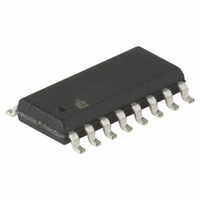HIP6302CBZ Intersil, HIP6302CBZ Datasheet - Page 8

HIP6302CBZ
Manufacturer Part Number
HIP6302CBZ
Description
IC CONTROLLER PWM BUCK 16-SOIC
Manufacturer
Intersil
Datasheet
1.HIP6302CBZ.pdf
(16 pages)
Specifications of HIP6302CBZ
Pwm Type
Controller
Number Of Outputs
2
Frequency - Max
305kHz
Voltage - Supply
4.75 V ~ 5.25 V
Buck
Yes
Boost
No
Flyback
No
Inverting
No
Doubler
No
Divider
No
Cuk
No
Isolated
No
Operating Temperature
0°C ~ 70°C
Package / Case
16-SOIC (3.9mm Width)
Frequency-max
305kHz
Lead Free Status / RoHS Status
Lead free / RoHS Compliant
Duty Cycle
-
Available stocks
Company
Part Number
Manufacturer
Quantity
Price
Company:
Part Number:
HIP6302CBZ/ICL6302CBZ
Manufacturer:
BCD
Quantity:
8
current, the signal applied via the summing Correction circuit
to the Comparator, reduces the output pulse width of the
Comparator to compensate for the detected “above average”
current in that channel.
Droop Compensation
In addition to control of each power channel’s output current,
the average channel current is also used to provide CORE
voltage “droop” compensation. Average full channel current
is defined as 50µA. By selecting an input resistor, R
amount of voltage droop required at full load current can be
programmed. The average current driven into the FB pin
results in a voltage increase across resistor R
direction to make the Error Amplifier “see” a higher voltage at
the inverting input, resulting in the Error Amplifier adjusting
the output voltage lower. The voltage developed across R
is equal to the “droop” voltage. See the “Current Sensing and
Balancing” section for more details.
Applications and Convertor Start-Up
Each PWM power channel’s current is regulated. This
enables the PWM channels to accurately share the load
current for enhanced reliability. The HIP6601, HIP6602 or
HIP6603 MOSFET driver interfaces with the HIP6302. For
more information, see the HIP6601, HIP6602 or HIP6603
data sheets.
The HIP6302 controls the two PWM power channels 180
out of phase. Figure 2 shows the out of phase relationship
between the two PWM channels.
Power supply ripple frequency is determined by the channel
frequency, F
For example, if the channel frequency is set to 250kHz, the
ripple frequency is 500kHz.
The IC monitors and precisely regulates the CORE voltage
of a microprocessor. After initial start-up, the controller also
provides protection for the load and the power supply. The
following section discusses these features.
Initialization
The HIP6302 usually operates from an ATX power supply.
Many functions are initiated by the rising supply voltage to
the V
Soft-Start and other functions are initialized during this
interval. These circuits are controlled by POR, Power-On
Reset. During this interval, the PWM outputs are driven to a
CC
FIGURE 2. TWO PHASE PWM OUTPUT AT 500kHz
pin of the HIP6302. Oscillator, Sawtooth Generator,
SW
, multiplied by the number of active channels.
8
IN
that is in the
IN
, the
PWM 2
PWM 1
o
IN
HIP6302
HIP6302
three state condition that makes these outputs essentially
open. This state results in no gate drive to the output
MOSFETS.
Once the V
level to insure proper internal function, the PWM outputs are
enabled and the Soft-Start sequence is initiated. If for any
reason, the V
POR circuit shuts the converter down and again three states
the PWM outputs.
Soft-Start
After the POR function is completed with V
4.375V, the Soft-Start sequence is initiated. Soft-Start, by its
slow rise in CORE voltage from zero, avoids an over-current
condition by slowly charging the discharged output
capacitors. This voltage rise is initiated by an internal DAC
that slowly raises the reference voltage to the error amplifier
input. The voltage rise is controlled by the oscillator
frequency and the DAC within the HIP6302, therefore, the
output voltage is effectively regulated as it rises to the final
programmed CORE voltage value.
For the first 32 PWM switching cycles, the DAC output
remains inhibited and the PWM outputs remain three stated.
From the 33rd cycle and for another, approximately 150
cycles the PWM output remains low, clamping the lower
output MOSFETs to ground, see Figure 3. The time
variability is due to the Error Amplifier, Sawtooth Generator
and Comparators moving into their active regions. After this
short interval, the PWM outputs are enabled and increment
the PWM pulse width from zero duty cycle to operational
pulse width, thus allowing the output voltage to slowly reach
the CORE voltage. The CORE voltage will reach its
programmed value before the 2048 cycles, but the PGOOD
output will not be initiated until the 2048th PWM switching
cycle.
The Soft-Start time or delay time, DT = 2048/F
oscillator frequency, F
160µs, the PWM outputs are held in a three state level as
explained above. After this period and a short interval
described above, the PWM outputs are initiated and the
voltage rises in 10.08ms, for a total delay time DT of
10.24ms.
Figure 3 shows the start-up sequence as initiated by a fast
rising 5V supply, V
short rise to the three state level in PWM 1 output during first
32 PWM cycles.
Figure 4 shows the waveforms when the regulator is
operating at 200kHz. Note that the Soft-Start duration is a
function of the Channel Frequency as explained previously.
Also note the pulses on the COMP terminal. These pulses
are the current correction signal feeding into the comparator
input (see the Block Diagram on page 2).
CC
CC
voltage reaches 4.375V (+125mV), a voltage
voltage drops below 3.875V (+125mV). the
CC,
SW
applied to the HIP6302. Note the
, of 200kHz, the first 32 cycles or
CC
reaching
December 27, 2004
SW
. For an
FN4766.3












